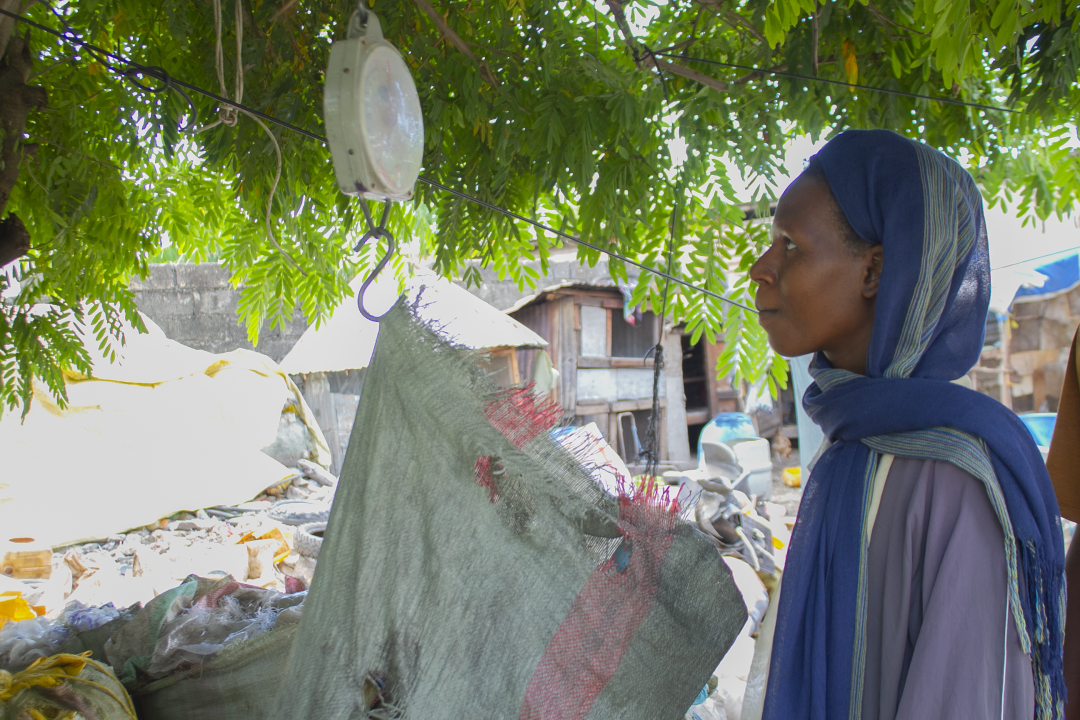Disclaimer:
Please be aware that the content herein has not been peer reviewed. It consists of personal reflections, insights, and learnings of the contributor(s). It may not be exhaustive, nor does it aim to be authoritative knowledge.
Learnings on your challenge
What are the top key insights you generated about your learning challenge during this Action Learning Plan? (Please list a maximum of 5 key insights)
The following are key learnings from this project:
First, the launch of a smartphone app (ZAIDI APP) for waste pickers in Tanga City is a big development. It demonstrates how digital innovation may disrupt traditional practices, empowering people by streamlining processes (such as data recording), allowing them to access social benefits and enhance their living situations. This observation highlights technology's capacity to drive positive change in unexpected places.
Second, the project has transformed rubbish pickers from marginalized workers to vital contributors to the city's economy and environmental stewards. This shift in attitude demonstrates the significance of recognizing and appreciating the efforts of all community members, regardless of career or social standing.
Third, we have leart that inclusivity can lead to sustainable development, as demonstrated by the project's method of incorporating rubbish pickers into a bigger economic and environmental endeavor. Integrating excluded communities into larger economic strategies provides opportunities for not only environmental advantages, but also social upliftment and economic prosperity.
Fourth, the relationship between the Taka Ni Ajira Foundation (NGO), the UNDP Accelerator Lab, and the City of Tanga exemplifies the power of collaborative efforts in generating systemic change.
Lastly, the project's success in Tanga City demonstrates the importance of collaboration among diverse sectors, including officials, investors, and community members, in order to make a substantial impact.
Considering the outcomes of this learning challenge, which of the following best describe the handover process? (Please select all that apply)
Our work has not yet scaled
Can you provide more detail on your handover process?
We anticipate the handover process to follow the following steps:
Planning the handover:
Set Objectives: Define clear handover objectives to ensure that all stakeholders understand the expected goals and outcomes.
Create a Timeline: Make a precise timeline for the handover process, including important milestones and deadlines.
Identify Stakeholders: List all project stakeholders, including the UNDP, Zaidi Recyclers, local officials, and any other relevant parties.
Documentation and Knowledge Transfer:
Compile Project Documentation: Gather all project-related documents, such as reports, data, contracts, and instructions.
Conduct training sessions. Set up training for Zaidi Recyclers and city officials to ensure they grasp the project's operational features, technologies, and best practices.
Share Lessons Learned. Communicate project insights and lessons learned so that future management can avoid similar problems and capitalize on successful strategies.
Transition of Responsibilities:
Define roles and responsibilities. Clearly define the roles and obligations of Zaidi Recyclers and the city of Tanga following transfer.
Set up support structures. Create support systems to address any concerns that may develop during the initial phase following the handover.
Legal and financial considerations:
Transfer Contracts and Agreements: Ensure that all contracts, agreements, and legal papers are correctly transferred and understood by the new management.
Outline your financial responsibilities. Clarify any current financial commitments, funding arrangements, and fiscal considerations.
Communication Strategies:
Internal Communication: Keep all team members and stakeholders informed about the handover process.
External Communication: Create public statements or press releases to tell the larger community about the management transition and its effects.
Finalizing the Handover:
Conduct a last review. Organize a meeting with all stakeholders to evaluate the handover process and ensure that all areas are addressed.
Sign-off: Obtain a formal signature from all relevant stakeholders, stating that the handover is complete and that all parties agree to the terms.
Post-Handover Support
Provide Ongoing Assistance: Provide ongoing support for a set period after handover to address any new concerns or questions.
Schedule Follow-up Meetings: Arrange for regular check-ins to ensure the project runs smoothly and to resolve any long-term issues.
Please paste any link(s) to blog(s) or publication(s) that articulate the learnings on your frontier challenge.
Data and Methods
Relating to your types of data, why did you chose these? What gaps in available data were these addressing?
The idea to use a triad of data types - citizen-generated data, app data, and financial data - was a stroke of genius in tackling the complex nature of trash management and community empowerment.
Citizen-generated data emerged as the community's voice, which was a critical component of the initiative. This information was collected directly from individuals on the ground, including rubbish pickers, local communities, and other stakeholders. Their views, observations, and criticism were invaluable. Why was this data selected? It highlighted ground-level realities and demands that more traditional data collection approaches could have overlooked. This form of data filled important gaps in understanding local realities and the project's immediate impact on daily life, providing a grassroots perspective that was both authentic and profoundly relevant.
Then followed the app data, which is the project's digital heartbeat. It was acquired using the unique smartphone app used by rubbish pickers and captured details such as the volume of waste collected, the sorts of materials utilized, and the location. The decision to employ app data was strategic, with the goal of providing systematic and consistent data for monitoring and analyzing the project's operations. This data type addresses the critical requirement for precise and timely information about waste management procedures, enabling efficient progress tracking, trend identification, and informed decision-making for improvement.
Finally, the financial data served as an economic prism through which to assess the project's profitability and sustainability. This included all economic variables, such as costs, income, investments, and the financial impact on waste pickers. Financial data was necessary to assess the project's economic viability. It contributed to quantifying economic consequences, assuring accountability, effective budgeting, and securing future funding or investments. Most importantly, it emphasized the economic worth of waste pickers' contributions, which is critical to their recognition and empowerment.
Together, these three forms of data - citizen-generated, app-generated, and financial - created a comprehensive narrative. They presented a balanced picture of the project, taking into account its social, operational, and economic components. This data-driven strategy was critical to assuring informed decision-making, effective administration, and the overall success of the endeavor to alter lives and the environment in Tanga.
Why was it necessary to apply the above innovation method on your frontier challenge? How did these help you to unpack the system?
Data ethnography, visualization, and Minimum Viable Product (MVP) innovation methods were used to address your frontier challenge in a strategic way that allowed us to deeply understand, effectively communicate, and efficiently test solutions within the complex system of waste management and community empowerment. Let's see how each strategy helped to unpack the system:
Data Ethnography:
Purpose: Data ethnography is a thorough examination of the community's cultural, sociological, and operational backdrop, with an emphasis on waste pickers' everyday experiences, motivations, and obstacles.
Why is this necessary? Data ethnography was vital for gaining deep insights into the lives of waste pickers and the community. This strategy goes beyond numbers to capture the human tales and social factors at play.
The impact on unpacking the system: Data ethnography contributed to a better understanding of the community's complex social structure and behavioral patterns. It added qualitative dimension to the data by revealing underlying concerns and motivations that quantitative data alone could not.
Visualization:
The goal of visualization is to translate complex data sets into understandable and entertaining graphical representations, such as charts, graphs, and maps.
Why is this necessary? Given the complexities of the data involved in waste management (such as volume, waste types, and geographic distribution), visualization was required to make this information accessible and understandable to all stakeholders, including nontechnical audiences.
The impact on unpacking the system: Visualization made it easier to spot patterns, trends, and abnormalities in data. It improved communication and understanding among stakeholders, allowing them to appreciate the complexities of the waste management process and its implications for the community.
Innovation: Minimum Viable Product (MVP)
MVP innovation entails creating a product with just enough features to satisfy early consumers and gather input for future improvement. In this sense, it most often refers to the first version of the mobile app or other technological solutions.
Why Necessary: MVP was critical for testing and refining technical solutions (such as the app) in a real-world setting without requiring significant upfront investment. It enabled iterative development based on actual user feedback and experiences.
The impact on unpacking the system: The MVP approach assisted in swiftly determining what works and what does not in a practical environment. It enables the project to adapt and evolve in response to real-world needs and issues faced by waste pickers and other stakeholders, fine-tuning the solution to meet the system's specific requirements.
Partners
Please indicate what partners you have actually worked with for this learning challenge.
Please state the name of the partner:
Taka ni Ajira foundation
What sector does your partner belong to?
Government (&related)
Please provide a brief description of the partnership.
In the project, the Taka Ni Ajira Foundation played a pivotal role in empowering waste pickers and advocating for their rights, while the Tanga City Council was instrumental in providing the necessary infrastructure and policy support for effective waste management.
Is this a new and unusual partner for UNDP?
Yes
Please indicate what partners you have actually worked with for this learning challenge.
Please state the name of the partner:
Tanga City council
What sector does your partner belong to?
Government (&related)
Please provide a brief description of the partnership.
n/a
Is this a new and unusual partner for UNDP?
No
End
Bonus question: How did the interplay of innovation methods, new forms of data and unusual partners enable you to learn & generate insights, that otherwise you would have not been able to achieve?
The interplay of innovative methods, diverse data forms, and the collaboration with unconventional partners like the Taka Ni Ajira Foundation and Tanga City Council created a unique synergy that enabled deep learning and the generation of insights otherwise unattainable. This collaborative approach allowed for a more holistic understanding of the waste management ecosystem by combining ground-level perspectives (through data ethnography and citizen-generated data) with technological innovation (via app data and MVP methods) and institutional support (from the Tanga City Council). This blend of diverse viewpoints, real-world data, and practical solutions facilitated a comprehensive understanding of both the challenges and opportunities within the system, leading to more effective, sustainable, and community-centric strategies for waste management and environmental stewardship.
Please upload any further supporting evidence / documents / data you have produced on your frontier challenge that showcase your learnings.
The closing form saves automatically or via the blue "save changes" button the top left. Thank you


 3Good health and well-being
3Good health and well-being 9Industry, innovation and infrastructure
9Industry, innovation and infrastructure

Comments
Log in to add a comment or reply.